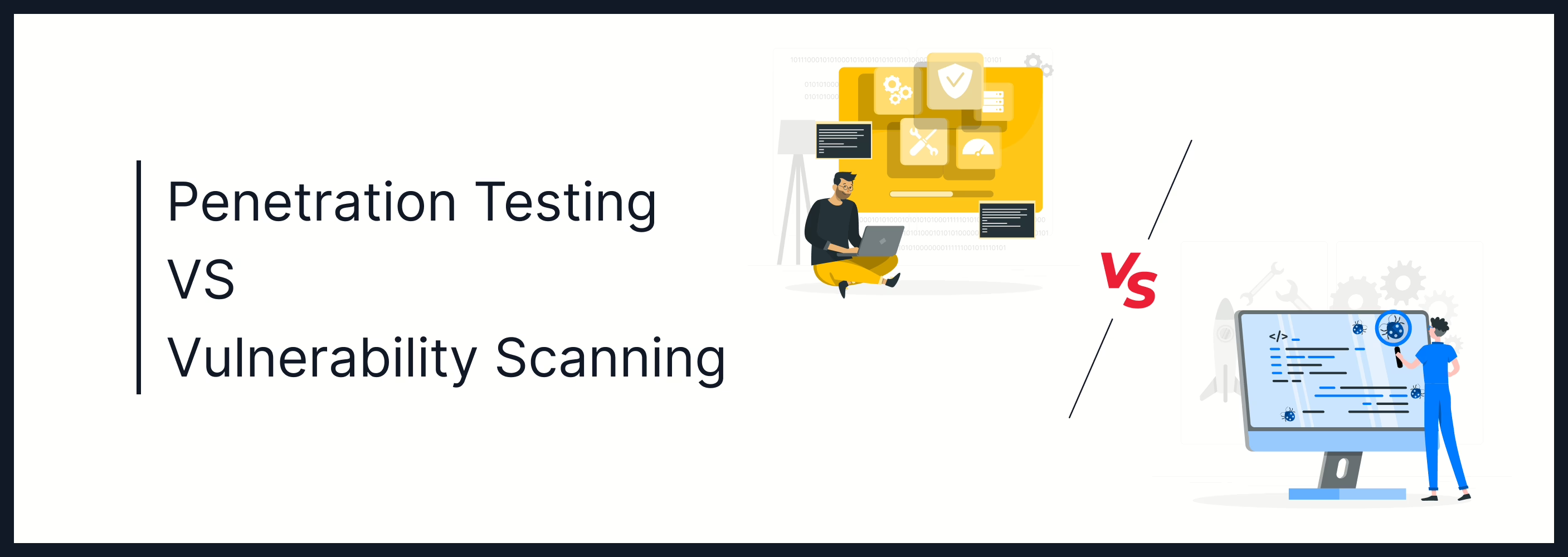
Oct 15, 2024 Information hub
Penetration Testing vs Vulnerability Scanning: Key Differences Explained
In today’s digital age, cybersecurity is no longer an afterthought but a critical component of any business strategy. With the increasing number of cyberattacks, data breaches, and sophisticated hacking techniques, organizations must take proactive measures to protect their digital assets. Two of the most commonly discussed and implemented security practices are penetration testing and vulnerability scanning. While these terms are often used interchangeably, they serve distinct purposes in the cybersecurity landscape.
In this blog post, we will explore the key differences between penetration testing and vulnerability scanning, their relevance in today’s cybersecurity environment, and how businesses can leverage both to enhance their security posture. By the end of this article, you will have a clear understanding of which approach is best suited for your organization and how to implement them effectively.
Introduction
In the ever-evolving world of cybersecurity, businesses are constantly seeking ways to stay ahead of cybercriminals. The stakes are high: a single data breach can cost millions of dollars, damage a company’s reputation, and lead to legal consequences. To mitigate these risks, organizations must regularly assess their security vulnerabilities and test their defenses.
Two of the most effective methods for identifying and addressing security weaknesses are penetration testing and vulnerability scanning. While both are essential components of a robust cybersecurity strategy, they serve different purposes and provide different insights into an organization’s security posture.
In this blog, we will delve into the differences between penetration testing and vulnerability scanning, explore their respective benefits, and discuss how they can be used together to create a comprehensive security strategy.
What is Vulnerability Scanning?
How Vulnerability Scanning Works
Vulnerability scanning is an automated process that identifies potential security weaknesses in a system, network, or application. It involves using specialized software tools to scan for known vulnerabilities, such as outdated software, misconfigurations, or missing patches. The goal of vulnerability scanning is to provide a comprehensive list of potential security issues that need to be addressed.
Vulnerability scanners work by comparing the target system against a database of known vulnerabilities, such as the Common Vulnerabilities and Exposures (CVE) database. Once the scan is complete, the tool generates a report that lists the vulnerabilities found, along with their severity levels and recommendations for remediation.
Types of Vulnerability Scans
There are several types of vulnerability scans, each designed to address different aspects of an organization’s security:
- Network Scans: These scans focus on identifying vulnerabilities in network devices, such as routers, firewalls, and switches. They check for open ports, weak passwords, and outdated firmware.
- Web Application Scans: These scans target web applications to identify vulnerabilities such as SQL injection, cross-site scripting (XSS), and insecure authentication mechanisms.
- Host-Based Scans: These scans focus on individual servers or workstations, checking for missing patches, misconfigurations, and outdated software.
- Database Scans: These scans are designed to identify vulnerabilities in database systems, such as weak encryption, insecure configurations, and missing patches.
What is Penetration Testing?
How Penetration Testing Works
Penetration testing, often referred to as “pen testing,” is a more in-depth and manual process that simulates a real-world cyberattack on a system, network, or application. The goal of penetration testing is to identify security weaknesses that could be exploited by attackers and to assess the effectiveness of existing security controls.
Unlike vulnerability scanning, which is automated, penetration testing is typically performed by skilled security professionals (often called ethical hackers or penetration testers). These experts use a combination of automated tools and manual techniques to exploit vulnerabilities and gain unauthorized access to systems. The process involves several stages, including reconnaissance, exploitation, and post-exploitation.
Types of Penetration Tests
Penetration tests can be categorized into several types based on the scope and objectives of the test:
- Black Box Testing: In this type of test, the penetration tester has no prior knowledge of the target system. This simulates an attack from an external hacker who has no insider information.
- White Box Testing: In white box testing, the tester has full knowledge of the target system, including access to source code, network diagrams, and other internal information. This allows for a more thorough assessment of security vulnerabilities.
- Gray Box Testing: Gray box testing is a hybrid approach where the tester has limited knowledge of the target system. This simulates an attack from an insider or a hacker with some level of access to the system.
Penetration Testing vs Vulnerability Scanning: Key Differences
While both penetration testing and vulnerability scanning are essential for identifying security weaknesses, they differ in several key areas. Understanding these differences is crucial for determining which approach is best suited for your organization’s needs.
Depth of Analysis
- Vulnerability Scanning: Vulnerability scanning provides a broad overview of potential security issues by identifying known vulnerabilities. However, it does not attempt to exploit these vulnerabilities or assess their real-world impact.
- Penetration Testing: Penetration testing goes beyond identifying vulnerabilities by actively exploiting them to determine their severity and potential impact. This provides a more in-depth analysis of the organization’s security posture.
Automation vs Manual Testing
- Vulnerability Scanning: Vulnerability scanning is largely automated, making it faster and more cost-effective. It can be run frequently to identify new vulnerabilities as they emerge.
- Penetration Testing: Penetration testing is a manual process that requires skilled professionals to simulate real-world attacks. While it is more time-consuming and expensive, it provides a more accurate assessment of security risks.
Frequency and Timing
- Vulnerability Scanning: Vulnerability scans can be run on a regular basis, such as weekly or monthly, to ensure that new vulnerabilities are identified and addressed promptly.
- Penetration Testing: Penetration tests are typically conducted less frequently, such as annually or after significant changes to the system. They are often used to complement vulnerability scanning by providing a deeper assessment of security risks.
Cost and Resource Allocation
- Vulnerability Scanning: Due to its automated nature, vulnerability scanning is generally more affordable and requires fewer resources. It is an ideal solution for organizations with limited budgets or those looking for a quick overview of their security posture.
- Penetration Testing: Penetration testing is more resource-intensive and expensive, as it requires skilled professionals to perform the tests. However, the insights gained from penetration testing are often more valuable, as they provide a realistic assessment of the organization’s security defenses.
Practical Examples and Case Studies
To better understand the differences between penetration testing and vulnerability scanning, let’s look at a few real-world examples and case studies.
Example 1: Vulnerability Scanning in a Financial Institution
A large financial institution regularly conducts vulnerability scans on its network to identify potential security weaknesses. During one scan, the tool identified several outdated software versions on the company’s servers. The IT team was able to quickly apply patches and update the software, reducing the risk of exploitation.
Example 2: Penetration Testing in a Healthcare Organization
A healthcare organization hired a penetration testing firm to assess the security of its patient data management system. The penetration testers were able to exploit a misconfigured database and gain access to sensitive patient records. The organization was able to fix the issue before any real-world attackers could exploit it, preventing a potential data breach.
Current Trends and Challenges
Rise of Automated Tools
As cybersecurity threats continue to evolve, there has been a growing trend towards the use of automated tools for both vulnerability scanning and penetration testing. These tools leverage artificial intelligence (AI) and machine learning (ML) to identify and exploit vulnerabilities more efficiently. However, while automation can improve the speed and accuracy of testing, it cannot fully replace the expertise of human penetration testers.
Challenges in Cybersecurity Testing
One of the biggest challenges in cybersecurity testing is the sheer volume of vulnerabilities that organizations must address. With new vulnerabilities being discovered every day, it can be difficult for businesses to keep up. Additionally, many organizations lack the resources or expertise to conduct thorough penetration tests, leaving them vulnerable to attacks.
Benefits of Combining Penetration Testing and Vulnerability Scanning
While penetration testing and vulnerability scanning serve different purposes, they are most effective when used together as part of a comprehensive security strategy. Here are some of the key benefits of combining both approaches:
- Comprehensive Coverage: Vulnerability scanning provides a broad overview of potential security issues, while penetration testing offers a deeper analysis of the most critical vulnerabilities.
- Proactive Security: Regular vulnerability scans help organizations stay ahead of emerging threats, while penetration tests provide a realistic assessment of how well their defenses hold up against real-world attacks.
- Cost-Effective: By using vulnerability scanning to identify and address low-hanging fruit, organizations can focus their penetration testing efforts on the most critical areas, reducing overall costs.
Conclusion
In the battle against cyber threats, both penetration testing and vulnerability scanning play crucial roles in identifying and mitigating security risks. While vulnerability scanning provides a broad, automated assessment of potential weaknesses, penetration testing offers a more in-depth, manual evaluation of how those vulnerabilities can be exploited in real-world scenarios.
For organizations looking to enhance their cybersecurity posture, the best approach is to use both methods in tandem. Regular vulnerability scans can help identify new vulnerabilities as they emerge, while periodic penetration tests provide a deeper understanding of the organization’s security defenses.
By combining these two approaches, businesses can stay one step ahead of cybercriminals and protect their valuable digital assets from harm.
Actionable Takeaways:
- Conduct regular vulnerability scans to identify and address known vulnerabilities.
- Schedule periodic penetration tests to assess the effectiveness of your security controls.
- Use a combination of both methods for a comprehensive security strategy.
- Stay informed about the latest cybersecurity trends and tools to ensure your defenses remain up-to-date.
In the end, the key to effective cybersecurity is not choosing between penetration testing and vulnerability scanning, but understanding how to use both to their fullest potential.
